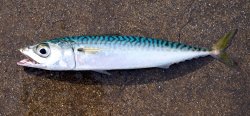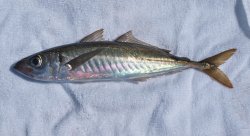Mackerel. Two species of fish are sold as “mackerel” in California bait shops although only one is a true mackerel. The most commonly seen is the Pacific mackerel, Scomber japonicus, the true mackerel. Most often it is simply called mackerel but sometimes it is given the appellation chub, green mackerel or blue mackerel. The second type you will encounter is jack mackerel, Trachurus symmetricus that is usually called Spanish mackerel; it is actually a member of the jack family. Both can be excellent baits but there are differences.
Pacific mackerel are good bait for many species, especially other Pacific mackerel and bottom species such as bass, yellowfin croaker, white croaker, halibut, sole and turbots. The flesh is very oily and bloody and because of this it is one of the best baits for sharks and rays, including shovelnose guitarfish, bat rays, smoothhound sharks, leopard sharks, and larger sharks. Most anglers simply cut out a chunk of the mackerel for the bait but it is better to cut it in a triangular pattern (like strip bait) and place the hook in the wider end of the bait. For smaller species, the piece may only be an inch or so in length while those seeking the larger sharks may cut a fillet off one side of a mackerel that is several inches in length. If you cut the mackerel into strip bait, and are using a fairly large mackerel, remember to trim off the excess flesh. Keep the bait somewhat thin. Spanish mackerel is used in a similar manner but it is less oily and not as good a bait.
Unusual but excellent bait is the “strawberry,” a bloody mass of sacs, which are attached to the intestines of Pacific mackerel. At first glance this mass of flesh looks rather nasty but it is often the best piece of the mackerel. In fact, other mackerel really seem to be turned on (shades of the ‘60s) by this bloody sac and will attack it in a frenzied manner.
A problem with Pacific mackerel, but not as much with jack mackerel, is that it softens up quickly when left out in the hot sun; it should always be kept cool. If allowed to heat, the flesh becomes soft and easily falls off the hook. Years ago one could buy sugar-cured mackerel. This was superior bait but today it is almost impossible to find. You will occasionally see salted mackerel; it holds up better than frozen mackerel and is about as good a bait.
Both of these species are excellent live bait when you can acquire the miniature 4-6 inch fish (a.k.a. babies). At times they are thick around piers and that is the time to break out the multi-hook bait rigs, i.e., Lucky Lura or Sabiki riggings.
Halibut lurking on the bottom sands in the depressions between pilings love to dart up and grab a small mackerel. Sharks and rays love a bloody piece of mackerel sitting on the bottom or mid-depth. Thresher sharks like nothing better than a mid-size mackerel being used as live bait in top water areas. And yellowtail, when they come around the piers in the fall months, go somewhat giddy when they see a live mackerel jack (Spanish mackerel) being used as live bait. White seabass too, the larger mamas and papas as well as the smaller, so-called “seatrout,” also love live bait and both Pacific mackerel and jack mackerel make up part of their diet.
Pacific mackerel are good bait for many species, especially other Pacific mackerel and bottom species such as bass, yellowfin croaker, white croaker, halibut, sole and turbots. The flesh is very oily and bloody and because of this it is one of the best baits for sharks and rays, including shovelnose guitarfish, bat rays, smoothhound sharks, leopard sharks, and larger sharks. Most anglers simply cut out a chunk of the mackerel for the bait but it is better to cut it in a triangular pattern (like strip bait) and place the hook in the wider end of the bait. For smaller species, the piece may only be an inch or so in length while those seeking the larger sharks may cut a fillet off one side of a mackerel that is several inches in length. If you cut the mackerel into strip bait, and are using a fairly large mackerel, remember to trim off the excess flesh. Keep the bait somewhat thin. Spanish mackerel is used in a similar manner but it is less oily and not as good a bait.
Unusual but excellent bait is the “strawberry,” a bloody mass of sacs, which are attached to the intestines of Pacific mackerel. At first glance this mass of flesh looks rather nasty but it is often the best piece of the mackerel. In fact, other mackerel really seem to be turned on (shades of the ‘60s) by this bloody sac and will attack it in a frenzied manner.
A problem with Pacific mackerel, but not as much with jack mackerel, is that it softens up quickly when left out in the hot sun; it should always be kept cool. If allowed to heat, the flesh becomes soft and easily falls off the hook. Years ago one could buy sugar-cured mackerel. This was superior bait but today it is almost impossible to find. You will occasionally see salted mackerel; it holds up better than frozen mackerel and is about as good a bait.
Both of these species are excellent live bait when you can acquire the miniature 4-6 inch fish (a.k.a. babies). At times they are thick around piers and that is the time to break out the multi-hook bait rigs, i.e., Lucky Lura or Sabiki riggings.
Halibut lurking on the bottom sands in the depressions between pilings love to dart up and grab a small mackerel. Sharks and rays love a bloody piece of mackerel sitting on the bottom or mid-depth. Thresher sharks like nothing better than a mid-size mackerel being used as live bait in top water areas. And yellowtail, when they come around the piers in the fall months, go somewhat giddy when they see a live mackerel jack (Spanish mackerel) being used as live bait. White seabass too, the larger mamas and papas as well as the smaller, so-called “seatrout,” also love live bait and both Pacific mackerel and jack mackerel make up part of their diet.


